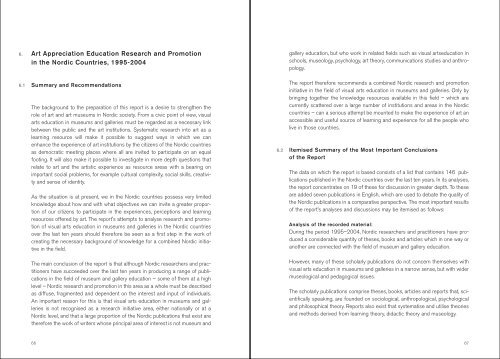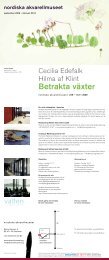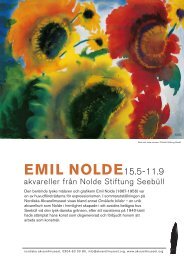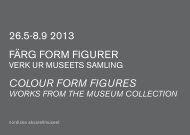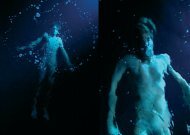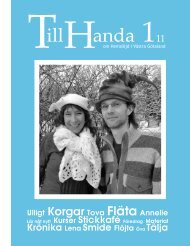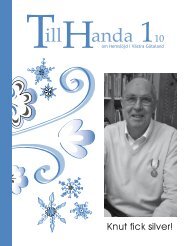Kunstpædagogisk forskning og formidling i Norden 1995 – 2004
Kunstpædagogisk forskning og formidling i Norden 1995 – 2004
Kunstpædagogisk forskning og formidling i Norden 1995 – 2004
Create successful ePaper yourself
Turn your PDF publications into a flip-book with our unique Google optimized e-Paper software.
6.<br />
6.1<br />
Art Appreciation Education Research and Promotion<br />
in the Nordic Countries, <strong>1995</strong>-<strong>2004</strong><br />
Summary and Recommendations<br />
The background to the preparation of this report is a desire to strengthen the<br />
role of art and art museums in Nordic society. From a civic point of view, visual<br />
arts education in museums and galleries must be regarded as a necessary link<br />
between the public and the art institutions. Systematic research into art as a<br />
learning resource will make it possible to suggest ways in which we can<br />
enhance the experience of art institutions by the citizens of the Nordic countries<br />
as democratic meeting places where all are invited to participate on an equal<br />
footing. It will also make it possible to investigate in more depth questions that<br />
relate to art and the artistic experience as resource areas with a bearing on<br />
important social problems, for example cultural complexity, social skills, creativity<br />
and sense of identity.<br />
As the situation is at present, we in the Nordic countries possess very limited<br />
knowledge about how and with what objectives we can invite a greater proportion<br />
of our citizens to participate in the experiences, perceptions and learning<br />
resources offered by art. The report's attempts to analyse research and promotion<br />
of visual arts education in museums and galleries in the Nordic countries<br />
over the last ten years should therefore be seen as a first step in the work of<br />
creating the necessary background of knowledge for a combined Nordic initiative<br />
in the field.<br />
The main conclusion of the report is that although Nordic researchers and practitioners<br />
have succeeded over the last ten years in producing a range of publications<br />
in the field of museum and gallery education <strong>–</strong> some of them at a high<br />
level <strong>–</strong> Nordic research and promotion in this area as a whole must be described<br />
as diffuse, fragmented and dependent on the interest and input of individuals.<br />
An important reason for this is that visual arts education in museums and galleries<br />
is not rec<strong>og</strong>nised as a research initiative area, either nationally or at a<br />
Nordic level, and that a large proportion of the Nordic publications that exist are<br />
therefore the work of writers whose principal area of interest is not museum and<br />
gallery education, but who work in related fields such as visual artseducation in<br />
schools, museol<strong>og</strong>y, psychol<strong>og</strong>y, art theory, communications studies and anthropol<strong>og</strong>y.<br />
The report therefore recommends a combined Nordic research and promotion<br />
initiative in the field of visual arts education in museums and galleries. Only by<br />
bringing t<strong>og</strong>ether the knowledge resources available in this field <strong>–</strong> which are<br />
currently scattered over a large number of institutions and areas in the Nordic<br />
countries <strong>–</strong> can a serious attempt be mounted to make the experience of art an<br />
accessible and useful source of learning and experience for all the people who<br />
live in those countries.<br />
Itemised Summary of the Most Important Conclusions<br />
of the Report<br />
The data on which the report is based consists of a list that contains 146 publications<br />
published in the Nordic countries over the last ten years. In its analyses,<br />
the report concentrates on 19 of these for discussion in greater depth. To these<br />
are added seven publications in English, which are used to debate the quality of<br />
the Nordic publications in a comparative perspective. The most important results<br />
of the report’s analyses and discussions may be itemised as follows:<br />
Analysis of the recorded material:<br />
During the period <strong>1995</strong><strong>–</strong><strong>2004</strong>, Nordic researchers and practitioners have produced<br />
a considerable quantity of theses, books and articles which in one way or<br />
another are connected with the field of museum and gallery education.<br />
However, many of these scholarly publications do not concern themselves with<br />
visual arts education in museums and galleries in a narrow sense, but with wider<br />
museol<strong>og</strong>ical and pedag<strong>og</strong>ical issues.<br />
The scholarly publications comprise theses, books, articles and reports that, scientifically<br />
speaking, are founded on sociol<strong>og</strong>ical, anthropol<strong>og</strong>ical, psychol<strong>og</strong>ical<br />
and philosophical theory. Reports also exist that systematise and utilise theories<br />
and methods derived from learning theory, didactic theory and museol<strong>og</strong>y.<br />
66 67<br />
6.2


